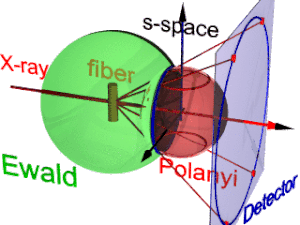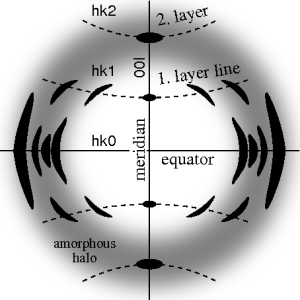Fiber diffraction
Fiber diffraction is a technique for studying molecular structures by analyzing diffraction images . These images are created when the sample is irradiated. X-rays , electrons or neutrons are usually used for this. The specialty of fiber diffraction is that the scattering pattern does not change when the sample is rotated around a certain axis (the fiber axis). Such uniaxial symmetry is typical for filaments or fibers made of biological or synthetic macromolecules ( polymers , plastics ). For crystallography , fiber symmetry represents a difficulty in determining the crystal structure. Compared to the diffraction diagram of the single crystal, the reflections in the fiber diagram are smeared and can overlap. The materials science considered fiber symmetry as a simplification, because almost the entire structure accessible information is contained in a single two-dimensional (2D) diffraction pattern. Such an image is exposed on photographic film or a 2D detector (like a digital camera). 2 instead of 3 coordinate axes are sufficient to describe fiber diffraction.
The ideal fiber scattering pattern shows 4-quadrant symmetry. In such a picture the direction of the fiber axis is called the meridian , the direction perpendicular to it is the equator . If fiber symmetry prevails, then in the 2D image there are many more reflections (illuminated "points") than in the diffraction image of the single crystal. These reflections appear to be arranged on lines (layer lines) that run roughly parallel to the equator. The layer line concept of crystallography thus becomes apparent in the fiber diffraction image. The bending of the layer lines results from the use of a flat film or detector; the diffraction image must be rectified in order to obtain straight layer lines. Reflexes are identified by Laue indices hkl (they correspond to Miller indices , but are not coprime). These are 3 digits. Reflections on the i th layer line have l = i if the fiber axis corresponds to the crystallographic c-axis. Reflexes on the meridian are 00l reflexes. Artificial fiber diffraction images are also generated in crystallography ( rotary crystal method ). A single crystal is rotated around an axis in the X-ray beam.
Real fiber scattering images are obtained in the experiment. They only show mirror symmetry because the fiber axis is not perfectly perpendicular to the incident beam. The corresponding geometric distortion has been studied in detail by Michael Polanyi at the Kaiser Wilhelm Institute for Fiber Chemistry under the head of Reginald Oliver Herzog . To describe the geometry, he introduced the elegant concept of the Polanyi sphere (originally: "layer sphere"). Later, Rosalind Franklin and Raymond Gosling gave an approximation formula for determining the fiber tilt angle β based on their own geometric considerations. In the first analysis step, the fiber scatter image is rectified and mapped onto the representative fiber plane. This is the plane that contains the cylinder axis of the reciprocal space . In crystallography, an approximation of the mapping in the reciprocal space is first calculated, which is refined iteratively. The digital method, often referred to as Fraser correction , starts with the Franklin approximation. It eliminates the tilt, rectifies the image and corrects the scattering intensity. The correct formula for the determination of β was given by Norbert Stribeck.
Historical role
Fiber diffraction led to several important advances in the development of structural biology, e.g. B. the first models of the α-helix and the Watson-Crick model of double-stranded DNA .
Fiber diffraction geometry

The geometry of the fiber diffraction is shown in the figure. It is based on the representation proposed by Polanyi. The reference direction is the primary ray (inscription: X-ray). If the fiber is tilted from the vertical by the angle β, the information about its structure also tilts in the reciprocal space (s-space). In the s-space, the Ewald sphere is a sphere whose center is in the sample. Its radius is 1 / λ, where λ is the wavelength of the incident radiation. All the points of reciprocal space that are seen by the planar detector lie on the surface of the Ewald sphere. They are mapped onto the detector's pixels by central projection.
In reciprocal space, each reflex lies on its Polanyi sphere. The ideal reflex actually represents a point in s-space. Because of the fiber symmetry, however, it smears into a ring around the fiber direction. Two rings represent a reflex on the Polanyi sphere because scattering is point-symmetric to the origin of the reciprocal space. Only the points that lie on both the Ewald sphere and the Polanyi sphere are mapped onto the detector . These points form the reflection circle (blue ring). It does not change when the sample is tilted. Like a slide projector (red rays), it is mapped onto the detector ( detector circle , blue ring). Up to 4 images of the observed reflex appear there (red dots). The position of the reflex images is determined by the orientation of the fiber in the beam ( Polanyi equation ). Conversely, the orientation of the fiber can be determined from the position of the reflex images if the following applies to the Laue indices hkl: and . From the Polanyi representation one derives the relationships of the fiber image by applying elementary and spherical geometry .
Correction of the spreading pattern
The figure on the left shows a typical fiber scattering pattern of polypropylene before the transformation into the reciprocal space. The mirror axis of the spread pattern is rotated by the angle from the vertical. This deficit is compensated for by simply rotating the image. 4 straight arrows point to 4 reflex images of the reference reflex. Their positions are used to determine the fiber tilt angle . The picture was taken with a CCD detector. It shows the logarithmic intensities in a false color representation. Light colors mean high intensity here.
After determining , the distance between the sample and the detector is calculated from the known crystallographic data of the reference reflex, a uniformly rastered map of the fiber plane of the reciprocal space is created and the data of the diffraction image is entered on this map. The figure on the right shows the result. The equalization also changes the scatter intensities. Due to the curvature of the surface of the Ewald sphere, white areas remain on the meridian in which structural information is missing. There is structural information on the meridian only in the center of the image and with an s-value that belongs to the scattering angle . In principle, the picture now shows 4-quadrant symmetry. In the example, part of the missing information could be copied "from bottom to top" into the white areas. So it often makes sense to consciously tilt the fiber.
The three-dimensional picture shows that the information about the molecular structure of the polypropylene fiber obtained in the example experiment is almost complete. By rotating the flat scatter pattern in the s-space around the meridian, the fiber scatter data measured in 4 s fill an almost spherical volume of the s-space. In the example, the 4-quadrant symmetry has not yet been used to fill white spots. For the demonstration, a quarter was cut out of the front of the sphere, but the equatorial plane itself was not removed.
literature
Original article
- W. Bian, H. Wang, I. McCullogh, G. Stubbs: WCEN: a computer program for initial processing of fiber diffraction patterns. In: J. Appl. Cryst. 39, 2006, pp. 752-756.
- W. Cochran, FHC Crick, V. Vand: The Structure of Synthetic Polypeptides. I. The Transform of Atoms on a Helix. In: Acta Cryst. 5, 1952, pp. 581-586.
- RE Franklin, RG Gosling: The Structure of Sodium Thymonucleate Fibers. II. The Cylindrical Symmetrical Patterson Function. In: Acta Cryst. 6, 1953, pp. 678-685.
- RDB Fraser, TP Macrae, A. Miller, RJ Rowlands: Digital Processing of Fiber Diffraction Patterns. In: J. Appl. Cryst. 9, 1976, pp. 81-94.
- RP Millane, S. Arnott: Digital Processing of X-Ray Diffraction Patterns from Oriented Fibers. In: J. Macromol. Sci. Phys. B24, 1985, pp. 193-227.
- M. Polanyi: The X-ray fiber diagram (first communication). In: Z. Physics. 7, 1921, pp. 149-180.
- M. Polanyi, K. Weissenberg: The X-ray fiber diagram (second part). In: Z. Physics. 9, 1923, pp. 123-130.
- G. Rajkumar, H. AL-Khayat, F. Eakins, A. He, C. Knupp, J. Squire: FibreFix - A New Integrated CCP13 Software Package. ( Memento of October 4, 2011 in the Internet Archive ) (PDF; 3.7 MB), In: Fiber Diffraction Rev. 13, 2005, pp. 11-18.
- N. Stribeck: On the determination of fiber tilt angles in fiber diffraction. In: Acta Cryst. A65, 2009, pp. 46-47.
- Mohamed Saad: Low resolution structure and packing investigations of collagen crystalline domains in tendon using Synchrotron Radiation X-rays, Structure factors determination, evaluation of Isomorphous Replacement methods and other modeling. PhD thesis. Université Joseph Fourier Grenoble, 1994.
Textbooks
- LE Alexander: X-Ray Diffraction Methods in Polymer Science. Wiley, New York 1979.
- HP Klug, LE Alexander: X-Ray Diffraction Procedures For Polycrystalline and Amorphous Materials. 2nd Edition. Wiley, New York 1974.
- BE Warren: X-Ray Diffraction. Dover, New York 1990, ISBN 0-486-66317-5 .
Web links
- Fiber Diffraction Review. ( Memento of October 4, 2011 in the Internet Archive ) Publications of the CCP13 Fiber Diffraction Software Project
- FibreFix ( Memento of October 4, 2011 in the Internet Archive ) - Windows software for the analysis of fiber patterns
- WCEN - software (Linux, Mac, Windows) for the analysis of fiber patterns
- Fiber Diffraction - an introduction provided by Prof. KC Holmes, Max Planck Institute for Medical Research, Heidelberg.
Individual evidence
- ↑ Mohamed Saad: Low resolution structure and packing investigations of collagen crystalline domains in tendon using Synchrotron Radiation X-rays, Structure factors determination, evaluation of Isomorphous Replacement methods and other modeling . PhD Thesis, Université Joseph Fourier Grenoble I, October 1994, doi : 10.13140 / 2.1.4776.7844 .








